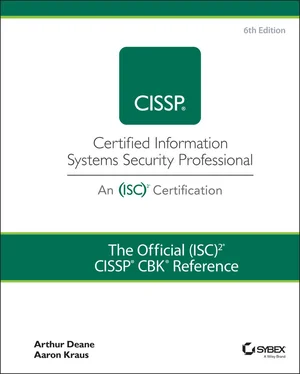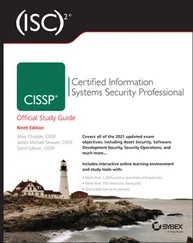Privacy and information security go hand in hand. As discussed earlier in this chapter, privacy is effectively the security principle of confidentiality applied to personal data. There are several important regulations around the globe that establish privacy and data protection requirements. As a security professional, it's important that you understand each privacy regulation that governs your jurisdiction. As a CISSP, you may be familiar with the following regulations, among others, depending on your jurisdiction:
U.S. Federal Privacy Act of 1974
U.S. Health Insurance Portability and Accountability Act (HIPAA) of 1996
U.S. Children's Online Privacy Protection Act (COPPA) of 1998
U.S. Gramm-Leach-Bliley Act (GLBA) of 1999
U.S. Health Information Technology for Economic and Clinical Health Act (HITECH) of 2009
Data Protection Directive (EU)
Data Protection Act 1998 (UK)
Safe Harbor
EU-US Privacy Shield
General Data Protection Regulation (GDPR) (EU)
NOTEThe Asia-Pacific Economic Cooperation (APEC) Privacy Framework is intended to provide member nations and economies with a flexible and consistent approach to information privacy protection without unnecessarily stifling information flow. Although it's not a law or regulation, the APEC Privacy Framework aims to improve information sharing with a common set of privacy principles and is worth reading if you do business in an APEC member economy.
U.S. Federal Privacy Act of 1974, 5 U.S.C. § 552a
The Federal Privacy Act is a U.S. law that was enacted in 1974. The Privacy Act establishes and governs practices related to the collection, maintenance, use, and dissemination of PII by U.S. government agencies. The purpose of the Privacy Act is to balance the government's need to maintain information about citizens and permanent residents with the rights of those individuals to keep their personal information private. Among its provisions, the Privacy Act states that “no agency shall disclose any record which is contained in a system of records by any means of communication to any person, or to another agency, except pursuant to a written request by, or with the prior written consent of, the individual to whom the record pertains.” Although the Privacy Act of 1974 substantially predates the internet, the provisions within the act continue to remain relevant and manifest in the form of online privacy consent forms and other mechanisms used to serve as “written consent of the individual.”
NOTECriminal violations of the Federal Privacy Act are deemed misdemeanors and may be subject to penalties of up to $5,000 per violation.
U.S. Health Insurance Portability and Accountability Act of 1996
HIPAA was signed into law in 1996, while the HIPAA Privacy Rule and Security Rule each went into effect in 2003. Organizations that must comply with HIPAA requirements are known as covered entities and fit into three categories:
Health plans: This includes health insurance companies, government programs like Medicare, and military and veteran's health programs that pay for healthcare.
Healthcare providers: This includes hospitals, doctors, nursing homes, pharmacies, and other medical providers that transmit health information.
Healthcare clearinghouses: This includes public and private organizations, like billing services, that process or facilitate the processing of nonstandard health information and convert it into standard data types. A healthcare clearinghouse is usually the intermediary between a healthcare provider and a health plan or payer of health services.
The HIPAA Privacy Rule establishes minimum standards for protecting a patient's privacy and regulates the use and disclosure of individuals' health information, referred to as protected health information . Under HIPAA, an individual's PHI is permitted to be used strictly for the purposes of performing and billing for healthcare services and must be protected against improper disclosure or use.
The HIPAA Security Rule establishes minimum standards for protecting PHI that is stored or transferred in electronic form. The Security Rule operationalizes the Privacy Rule by establishing the technical, physical, and administrative controls that covered entities must put in place to protect the confidentiality, integrity, and availability of electronically stored PHI (or e-PHI).
Civil penalties for HIPAA violation may include fines that range from $100 to $50,000 per violation, with a maximum penalty of $1.5 million per year for similar violations. Criminal penalties include fines up to $250,000 and potential imprisonment up to 10 years.
U.S. Children's Online Privacy Protection Act of 1998
The Children's Online Privacy Protection Act of 1998 is a U.S. federal law that establishes strict guidelines for online businesses to protect the privacy of children under the age of 13. COPPA applies to any organization around the world that handles the data of children residing in the United States and also applies to children that reside outside of the United States, if the company is U.S.-based. The law sets requirements for seeking parental consent and establishes restrictions on marketing to children under the age of 13.
NOTEAccording to the Federal Trade Commission (FTC), civil penalties of up to $43,280 may be levied for each violation of COPPA.
U.S. Gramm-Leach-Bliley Act of 1999
The Gramm-Leach-Bliley Act, also known as the Financial Services Modernization Act of 1999, is a U.S. law that requires financial institutions to safeguard their customer's PII. Among the provisions within GLBA, the Financial Privacy Rule requires that financial institutions provide each customer with a written privacy notice that explains what personal information is collected from the customer, how it is used, and how it is protected. The GLBA Safeguards Rule requires organizations to implement proper security controls to protect their customers' personal data.
Penalties for noncompliance with GLBA can include civil fines of up to $100,000 per violation for an organization, and up to $10,000 for officers and directors of a financial services company. In addition, criminal violations of GLBA can include revocation of licenses and up to five years in prison.
U.S. Health Information Technology for Economic and Clinical Health Act of 2009
The Health Information Technology for Economic and Clinical Health Act, referred to as the HITECH Act, was enacted under the American Recovery and Reinvestment Act of 2009. The HITECH Act was created to promote the expanded use of electronic health records (EHRs). Along with increased adoption, the act anticipated an increase in security and privacy risks. As such, the HITECH Act extended HIPAA privacy protections by improving security and privacy protections for healthcare data by imposing tougher penalties for HIPAA compliance violations. Under the HITECH Act, maximum financial penalties were raised to $1.5 million per violation category, per year.
The HITECH Act also introduced a new HIPAA Breach Notification Rule. Under this rule, covered entities are required to disclose a breach of unsecured protected health information to affected parties within 60 days of discovery of the breach. In addition to notifying affected individuals, the Breach Notification Rule requires covered entities to report breaches affecting 500 or more people to the U.S. Department of Health and Human Services and a major media outlet servicing the jurisdiction of the affected parties.
Data Protection Directive (EU)
The Data Protection Directive, officially known as Directive 95/46/EC, was enacted by the European Parliament in 1995. The Data Protection Directive aimed at regulating the processing of the personal data of European citizens. Although it has since been superseded by the GDPR (discussed in a later section), the Data Protection Directive was the first major privacy law in the European Union and is considered the foundational privacy regulation in all of Europe.
Читать дальше












